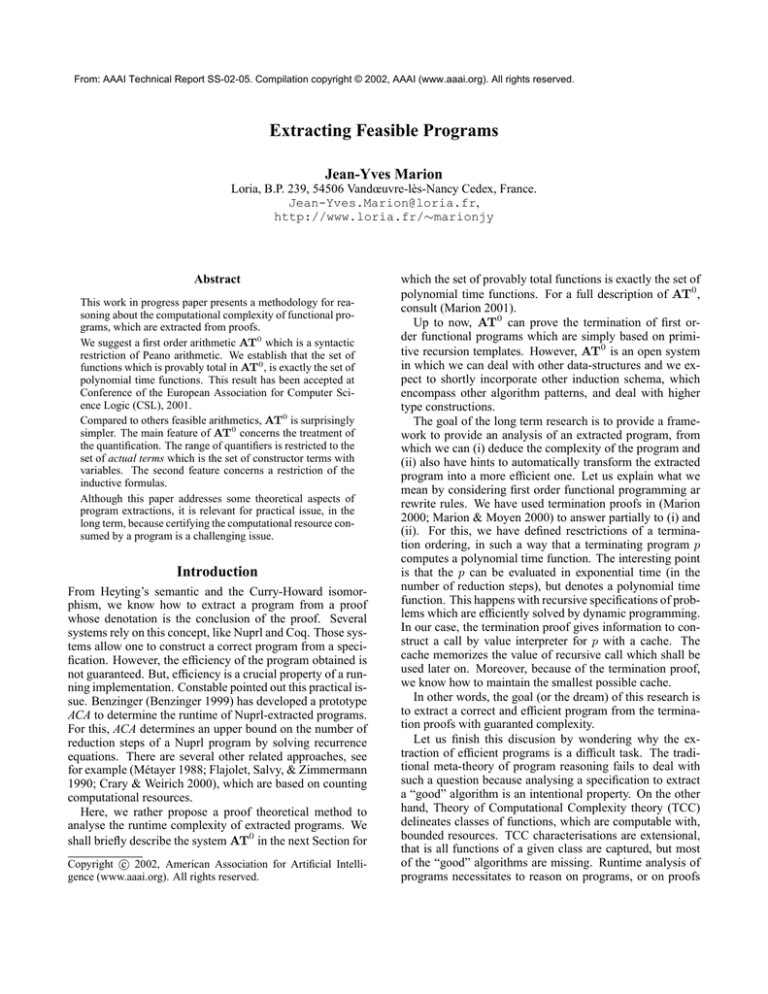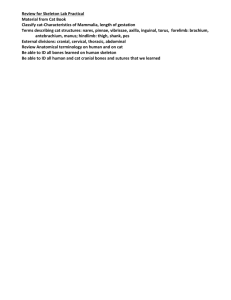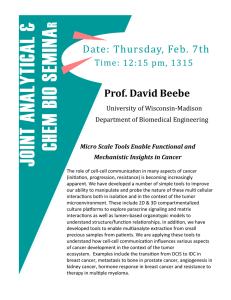
From: AAAI Technical Report SS-02-05. Compilation copyright © 2002, AAAI (www.aaai.org). All rights reserved.
Extracting Feasible Programs
Jean-Yves Marion
Loria, B.P. 239, 54506 Vandœuvre-lès-Nancy Cedex, France.
Jean-Yves.Marion@loria.fr,
http://www.loria.fr/∼marionjy
Abstract
This work in progress paper presents a methodology for reasoning about the computational complexity of functional programs, which are extracted from proofs.
We suggest a first order arithmetic AT0 which is a syntactic
restriction of Peano arithmetic. We establish that the set of
functions which is provably total in AT0 , is exactly the set of
polynomial time functions. This result has been accepted at
Conference of the European Association for Computer Science Logic (CSL), 2001.
Compared to others feasible arithmetics, AT0 is surprisingly
simpler. The main feature of AT0 concerns the treatment of
the quantification. The range of quantifiers is restricted to the
set of actual terms which is the set of constructor terms with
variables. The second feature concerns a restriction of the
inductive formulas.
Although this paper addresses some theoretical aspects of
program extractions, it is relevant for practical issue, in the
long term, because certifying the computational resource consumed by a program is a challenging issue.
Introduction
From Heyting’s semantic and the Curry-Howard isomorphism, we know how to extract a program from a proof
whose denotation is the conclusion of the proof. Several
systems rely on this concept, like Nuprl and Coq. Those systems allow one to construct a correct program from a specification. However, the efficiency of the program obtained is
not guaranteed. But, efficiency is a crucial property of a running implementation. Constable pointed out this practical issue. Benzinger (Benzinger 1999) has developed a prototype
ACA to determine the runtime of Nuprl-extracted programs.
For this, ACA determines an upper bound on the number of
reduction steps of a Nuprl program by solving recurrence
equations. There are several other related approaches, see
for example (Métayer 1988; Flajolet, Salvy, & Zimmermann
1990; Crary & Weirich 2000), which are based on counting
computational resources.
Here, we rather propose a proof theoretical method to
analyse the runtime complexity of extracted programs. We
shall briefly describe the system AT0 in the next Section for
c 2002, American Association for Artificial IntelliCopyright gence (www.aaai.org). All rights reserved.
which the set of provably total functions is exactly the set of
polynomial time functions. For a full description of AT0 ,
consult (Marion 2001).
Up to now, AT0 can prove the termination of first order functional programs which are simply based on primitive recursion templates. However, AT0 is an open system
in which we can deal with other data-structures and we expect to shortly incorporate other induction schema, which
encompass other algorithm patterns, and deal with higher
type constructions.
The goal of the long term research is to provide a framework to provide an analysis of an extracted program, from
which we can (i) deduce the complexity of the program and
(ii) also have hints to automatically transform the extracted
program into a more efficient one. Let us explain what we
mean by considering first order functional programming ar
rewrite rules. We have used termination proofs in (Marion
2000; Marion & Moyen 2000) to answer partially to (i) and
(ii). For this, we have defined resctrictions of a termination ordering, in such a way that a terminating program p
computes a polynomial time function. The interesting point
is that the p can be evaluated in exponential time (in the
number of reduction steps), but denotes a polynomial time
function. This happens with recursive specifications of problems which are efficiently solved by dynamic programming.
In our case, the termination proof gives information to construct a call by value interpreter for p with a cache. The
cache memorizes the value of recursive call which shall be
used later on. Moreover, because of the termination proof,
we know how to maintain the smallest possible cache.
In other words, the goal (or the dream) of this research is
to extract a correct and efficient program from the termination proofs with guaranted complexity.
Let us finish this discusion by wondering why the extraction of efficient programs is a difficult task. The traditional meta-theory of program reasoning fails to deal with
such a question because analysing a specification to extract
a “good” algorithm is an intentional property. On the other
hand, Theory of Computational Complexity theory (TCC)
delineates classes of functions, which are computable with,
bounded resources. TCC characterisations are extensional,
that is all functions of a given class are captured, but most
of the “good” algorithms are missing. Runtime analysis of
programs necessitates to reason on programs, or on proofs
in the “proofs-as-programs” context. For this, we need to
develop logics to study algorithmic contents of proofs.
A feasible arithmetic
Terms are divided into different categories which are listed
in Figure 1. Actual terms are built up from constructors of
W, and variables of X , and forms the set T (W, X ). The
logical rules of AT are written in Figure 2.
The difference with the {→, ∧, ∀}-fragment of the minimal logic is the actual elimination quantifier principle which
is obtained by the ∀E S -rule.
Now, we extend AT to an arithmetic AT(W) in order to
reason about the free word algebra T (W). The set of words
is denoted by a unary predicate W together with the rules
displayed in Figure 3.
Following Martin-Löf (Martin-Löf 1984) and
Leivant (Leivant 1994a; 2000), the introduction rules
indicate the construction of words, and the elimination
rules specify the computational behaviour associated with
them. Both elimination rules, that is the induction rule
and the selection rule, are necessary, because of the actual
elimination quantifier principle. Indeed, the induction
rule schema Ind(W) corresponds to the usual induction.
However, the range of the universal quantifier is restricted
to actual terms. So, the last quantifier of the induction filters
the instantiation through the ∀E S -rule. Roughly speaking,
an induction is guarded by a universal quantifier, like a
proof-net box in linear logic.
On the other hand, the selection rule expresses that a word
t is either the empty word , or si (y) for some term y. We
shall employ the selection rule to perform definitions by
cases over words. Unlike the induction rule, the term t in
the conclusion of the selection rule can be any term. It is
worth noticing that the application of the selection rule is
restricted. There is no application of ∀E S -rule in the derivations πs0 and πs1 . Thus, we prohibit nested applications of
induction rule, inside the selection rule. Otherwise it would
be possible to unguard an induction.
Reasoning over programs
An equational program f is a set of (oriented) equations E.
Each equation is of the form f(p1 , · · · , pn ) → t where each
pi is an actual term, and corresponds to a pattern. The term
t is in T (W, F, X ) and each variable of t also appears in
f(p1 , · · · , pn ).
Definition A confluent equational program f computes a
function [[f]] over T (W) which is defined as follows.
For each wi , v ∈ T (W), [[f]](w1 , · · · , wn ) = v
iff the normal form of f(w1 , · · · , wn ) is v, otherwise
[[f]](w1 , · · · , wn ) is undefined.
Let f be an equational program. We define AT(f) as the
calculus AT(W) extended with the replacement rule below,
A[uθ]
A[vθ]
R
where (v → u) ∈ E and θ is a substitution X → T (W, X ).
Definition A function φ of arity n is provably total in
AT(W) iff there are an equational program f such that
φ = [[f]] and a derivation in AT(f) of
Tot(f) ≡ ∀x1 · · · xn .W(x1 ), · · · , W(xn ) → W(f(x1 , · · · , xn ))
Definition A formula A[x] is an induction formula if
∀x.W(x) → A[x] is the conclusion of an induction. Define
AT0 (W) as the restriction of AT(W) in which induction
formulas are just conjunctions of predicates (i.e. atomic formulas).
Theorem [Main result] A function φ is polynomial time
computable if and only if the function φ is provably total
in AT0 .
Example We begin with the word concatenation whose
equations are
cat(, w) → w
cat(si (x), w) → si (cat(x, w))
i = 0, 1
The derivation πcat in Fiugre 4 shows that the concatenation
is a provably total function of AT(cat).
Notice that the term w is any term, and so w can be substituted by a non-actual term. Let us investigate the word
multiplication whose equations are
mul(, x) → mul(si (y), x) → cat(x, mul(y, x))
i = 0, 1
The word multiplication is a provably total function as the
derivation in Figure 5 shows it.
Now, consider the equations defining the exponential :
exp() → s0 ()
exp(si (y)) → cat(exp(y), exp(y))
i = 0, 1
In order to establish that the program exp defines a provably
total function, we have to make an induction. At the induction step, under the assumptions W(exp(y)) and W(y), we
have to prove W(cat(exp(y), exp(y))). However, exp(y)
is not an actual term, and so we can not “plug in” the derivation πcat to conclude.
Related works
One of the main advantage of the system AT0 compare to
other approaches is that AT0 is conceptually simpler. Theories of feasible mathematics originate with Buss (Buss 1986)
on bounded arithmetic. Subsequently, Leivant (Leivant
1991) established that the functions provably total in second
order arithmetic with the comprehension axiom restricted
to positive existential formulas, are exactly the polynomial
time functions. Leivant (Leivant 1994a) also translated his
characterisation (Leivant 1994b) of feasible functions by
mean of ramified recursion. For this, he has introduced a
sequence of predicate N0 , N1 , . . . corresponding to copies
of N with increasing computational potential. Çağman, Ostrin and Wainer (Çağman, Ostrin, & Wainer 2000) defined
W3c
F 3f
X 3x
T (W) 3 w
T (W, F, X ) 3 t
T (W, X ) 3 p
(Constructors)
(Function symbols)
(Variables)
(Words)
(Terms)
(Actual terms)
| s0 | s1
f | g | h | . . . with fixed arities
x | y | z | ...
| s0 (w) | s1 (w)
| s0 (t) | s1 (t) | f(t1 , . . . , tn ) | x
| s0 (p) | s1 (p) | x
::=
::=
::=
::=
::=
::=
Figure 1: Categories of terms
Premiss :
A
(Predicate A)
Introduction rules
{A}
·
·
·
B
A→B
A→B
A1
A1 ∧ A2
∀x.A
A
B
→I
A2
A
Elimination rules
A1 ∧ A2
∧I
Aj
∧E
∀x.A
∀I
→E
A[x ← p]
∀E S , where p ∈ T (W, X )
Restrictions on the rules
• In ∀I-rule, x is not free in any premiss.
• In ∀E S -rule, p is an actual term, i.e. p ∈ T (W, X ).
Figure 2: Logical rules of AT.
Introduction rules
W()
I
W(t)
W(s0 (t))
s0 I
W(t)
W(s1 (t))
s1 I
Elimination rules
Selection
·
· πs 0
·
W(y) → A[s0 (y)]
·
· πs 1
·
W(y) → A[s1 (y)] A[] W(t)
A[t]
Induction
Sel(W)
∀y.A[y], W(y) → A[s0 (y)] ∀y.A[y], W(y) → A[s1 (y)] A[]
∀x.W(x) → A[x]
Ind(W)
Restrictions on the rules :
• In Sel(W)-rule, derivations of πs0 and πs1 do not use the rule ∀E S . The variable y must not occur in any assumption on
which A[t] depends.
Figure 3: Rules for word reasonning in AT(W)
{W(cat(z, w))}
W(si (cat(z, w)))
si I
R
{W(z)} W(cat(si (z), w))
================================ → I
W(z), W(cat(z, w)) → W(cat(si (z), w))
∀I
∀z.W(z), W(cat(z, w)) → W(cat(si (z), w))
W(w)
W(cat(, w))
∀x.W(x) → W(cat(x, w))
R
Ind(W)
Figure 4: Concatenation
{W(mul(z, x))}
·
· πcat [w ← mul(z, x)]
·
∀x.W(x) → W(cat(x, mul(z, x)))
W(x) → W(cat(x, mul(z, x)))
∀E S
{W(x)}
W(cat(x, mul(z, x)))
R
W(mul(si (z), x))
=============================== → I
W(z), W(mul(z, x)) → W(mul(si (z), x))
∀I
∀z.W(z), W(mul(z, x)) → W(mul(si (z), x))
→E
W()
I
W(mul(, x))
∀y.W(y) → W(mul(y, x))
============================ (∀E S ;→ I; ∀I; ∀I)
∀x.∀y.W(x), W(y) → W(mul(y, x))
Figure 5: Multiplication
R
a two sorted Peano arithmetic PA(; ) in the spirit of Bellantoni and Cook (Bellantoni & Cook 1992). They characterize the functions computable in linear space, and the
elementary functions. Predicates have two kinds of arguments : safe and normal. Quantifiers are allowed only over
safe terms and range over hereditary basic terms. In a recent
article (Leivant 2001), Leivant suggests a new direction by
giving some structural conditions on proof hipothesis and on
inductive formulas. There are also theories of feasible mathematics which are affiliated to linear logic. Girard, Scedrov
and Scott in (J.-Y. Girard 1992) have introduced bounded
linear logic, in which resources are explicitly counted. Then,
Girard (Girard 1998) constructed light linear logic which is
a second order logic with a new modality which controls
safely the resources. See also the works of Asperti (Asperti
1998) and Roversi (Roversi 1999). Lastly, Bellantoni and
Hofmann (Bellantoni & Hofmann 2000) and Schwichtenberg (Schwichtenberg ), have proposed feasible arithmetics
based on linear logic with extra counting modalities.
Comments
These examples illustrate that actual terms play a role similar to terms of higher tier (safe) used in ramified recursions, as defined by Bellantoni and Cook (Bellantoni &
Cook 1992), and Leivant in (Leivant 1994b). Intuitively, we
do not assume that two terms are equal just because they
have the same value. We are not concerned by term denotations, but rather by the resource necessary to evaluate a term,
or in other words, by term intention. From this point of view,
a non-actual term is unsafe. So, we have no justification to
quantify over non-actual terms. On the other hand, there are
no computation rules associated to actual terms, so they are
safe with respect to polynomial-time computation. In a way,
this idea is similar to “read-only” programs of Jones (Jones
1999).
The concept arising from the work of Simmons (Simmons
1988), Bellantoni and Cook (Bellantoni & Cook 1992) and
Leivant (Leivant 1994b), is the ramification of the domain
of computation and the ramification of recursion schemata.
One usually compares this solution with Russell’s type theory. One unattractive feature is that objects are duplicated
at different tiers. This drawback is eliminated here. It is
amazing to see that this solution seems related to Zermelo
or Quine answers to Russell’s type theory.
Lastly, the actual elimination quantifier principle reminds
one of logic with existence predicate, in which quantifiers
are supposed to range only over existing terms. The motivation is to take into account undefined terms. Such logics
have their roots in works of Weyl (Weyl 1921) and Heyting (Heyting 1930), and have since extensively studied and
are related to free logic.
References
Asperti, A. 1998. Light affine logic. In Thirteenth Annual
IEEE Symposium on Logic in Computer Science(LICS’98),
300–308.
Bellantoni, S., and Cook, S. 1992. A new recursion-
theoretic characterization of the poly-time functions. Computational Complexity 2:97–110.
Bellantoni, S., and Hofmann, M. 2000. A new ”feasible”
arithmetic. Journal of symbolic logic. to appear.
Benzinger, R. 1999. Automated complexity analysis of
NUPRL extracts. Ph.D. Dissertation, Cornell University.
Buss, S. 1986. Bounded arithmetic. Bibliopolis.
Çağman, N.; Ostrin, G.; and Wainer, S. 2000. Proof theoretic complexity of low subrecursive classes. In Bauer,
F. L., and Steinbrueggen, R., eds., Foundations of Secure
Computation, Foundations of Secure Computation, 249–
286. IOS Press Amsterdam.
Crary, K., and Weirich, S. 2000. Ressource bound certification. In ACM SIGPLAN-SIGACT symposium on Principles
of programming languages, POPL, 184 – 198.
Flajolet, P.; Salvy, B.; and Zimmermann, P. 1990. Automatic average-case analysis of algorithms. Technical Report 1233, INRIA.
Girard, J.-Y. 1998. Light linear logic. Information and
Computation 143(2):175–204. prsent LCC’94, LNCS 960.
Heyting, A. 1930. Die formalen regeln der intuitionischen logik. Sitzungsberichte der preussischen akademie
von wissenschaften 57–71.
J.-Y. Girard, A. Scedrov, P. S. 1992. A modular approach
to polynomial-time computability. Theoretical Computer
Science 97(1):1–66.
Jones, N. 1999. LOGSPACE and PTIME characterized
by programming languages. Theoretical Computer Science
228:151–174.
Leivant, D. 1991. A foundational delineation of computational feasiblity. In Proceedings of the Sixth IEEE Symposium on Logic in Computer Science (LICS’91).
Leivant, D. 1994a. Intrinsic theories and computational
complexity. In Logical and Computational Complexity,
volume 960 of Lecture Notes in Computer Science, 177–
194. Springer.
Leivant, D. 1994b. Predicative recurrence and computational complexity I: Word recurrence and poly-time. In
Clote, P., and Remmel, J., eds., Feasible Mathematics II.
Birkhäuser. 320–343.
Leivant, D. 2000. Intrinsic reasoning about functional programs I: first order theories. Annals of Pure and Applied
Logic. to appear.
Leivant, D. 2001. Termination proofs and complexity certification. In Proceedings of the third international workshop
on Implicit Computational Complexity.
Marion, J.-Y., and Moyen, J.-Y. 2000. Efficient first order
functional program interpreter with time bound certifications. In LPAR, volume 1955 of Lecture Notes in Computer
Science, 25–42. Springer.
Marion, J.-Y. 2000. Analysing the implicit complexity of
programs. Information and Computation. to appear.
Marion, J.-Y. 2001. Actual arithmetic and feasibility. In
Fribourg, L., ed., Computer Science Logic, Paris, volume
2142 of LNCS, 115–129. Springer.
Martin-Löf, P. 1984. Intuitionistic Type Theory. Bibliopolis.
Métayer, D. L. 1988. Ace : an automatic complexity evaluator. Transactions on programming languages and systems
10(2).
Roversi, L. 1999. A P-Time completeness proof for light
logics. In Computer Science Logic, 13th International
Workshop, CSL ’99, volume 1683 of Lecture Notes in Computer Science, 469–483.
Schwichtenberg, H. Feasible programs from proofs.
http://www.mathematik.uni-muenchen.de/∼schwicht/.
Simmons, H. 1988. The realm of primitive recursion.
Archive for Mathematical Logic 27:177–188.
Weyl, H. 1921. über die neue grundlagenkrise der mathematik. Mathematische zeitschrift.






